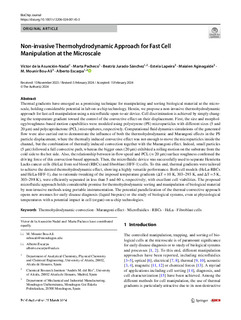
Title
Non-invasive Thermohydrodynamic Approach for Fast Cell Manipulation at the MicroscaleAuthor (from another institution)
Publication Date
2024Other institutions
Universidad de AlcaláVersion
Published versionDocument type
Journal ArticleJournal ArticleLanguage
EnglishRights
© 2024 The AuthorsAccess
Open accessPublisher’s version
https://doi.org/10.1007/s13206-024-00145-3Published at
BioChip Journal 2024Publisher
SpringerKeywords
Thermohydrodynamic convection
Marangoni effect
Microfluidics
RBCs ... [+]
Marangoni effect
Microfluidics
RBCs ... [+]
Thermohydrodynamic convection
Marangoni effect
Microfluidics
RBCs
HeLa
Fibroblast cells [-]
Marangoni effect
Microfluidics
RBCs
HeLa
Fibroblast cells [-]
Abstract
Thermal gradients have emerged as a promising technique for manipulating and sorting biological material at the microscale, holding considerable potential in lab-on-a-chip technology. Herein, we propo ... [+]
Thermal gradients have emerged as a promising technique for manipulating and sorting biological material at the microscale, holding considerable potential in lab-on-a-chip technology. Herein, we propose a non-invasive thermohydrodynamic approach for fast cell manipulation using a microfluidic open-to-air device. Cell discrimination is achieved by simply changing the temperature gradient toward the control of the convective effect on their displacement. First, the size and morphology/roughness-based motion capabilities were modeled using polystyrene (PS) microparticles with different sizes (5 and 20 μm) and polycaprolactone (PCL) microspheres, respectively. Computational fluid dynamics simulations of the generated flow were also carried out to demonstrate the influence of both the thermohydrodynamic and Marangoni effects in the PS particle displacement, where the thermally induced convective effect was not enough to move the microparticles inside the channel, but the combination of thermally induced convection together with the Marangoni effect. Indeed, small particles (5 μm) followed a full convective path, whereas the bigger ones (20 μm) exhibited a rolling motion on the substrate from the cold side to the hot side. Also, the relationship between in-flow speed and PCL (≈ 20 μm) surface roughness confirmed the driving force of this convection-based approach. Then, the microfluidic device was successfully used to separate Henrietta Lacks cancer cells (HeLa) from red blood (RBCs) and fibroblast (HFF-1) cells. To this end, thermal gradients were tailored to achieve the desired thermohydrodynamic effect, showing a highly versatile performance. Both cell models (HeLa-RBCs and HeLa-HFF-1), due to rationale tweaking of the imposed temperature gradients (ΔT = 10 K, 303–293 K, and ΔT = 5 K, 303–298 K), were efficiently separated in less than 5 and 60 s, respectively; with excellent cell viabilities. The proposed microfluidic approach holds considerable promise for thermohydrodynamic sorting and manipulation of biological material by non-invasive methods using portable instrumentation. The potential parallelization of the thermal-convective approach opens new avenues for early disease diagnosis (liquid biopsies) or the study of biological systems, even at physiological temperatures with a potential impact in cell (organ)-on-a-chip technologies. [-]
Collections
- Articles - Engineering [758]
The following license files are associated with this item:





















